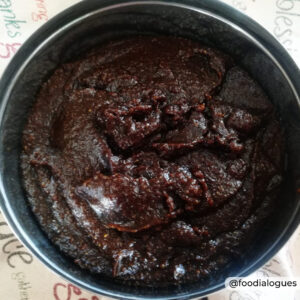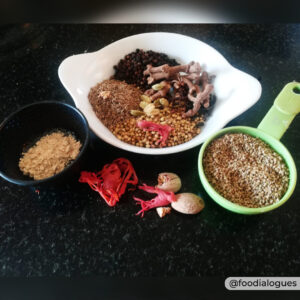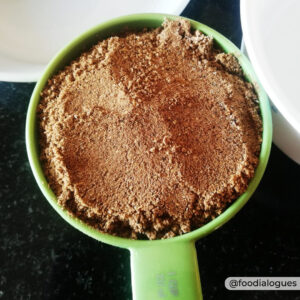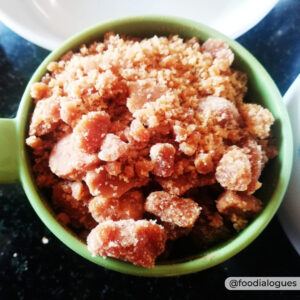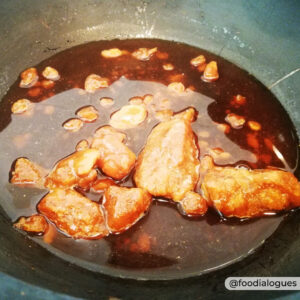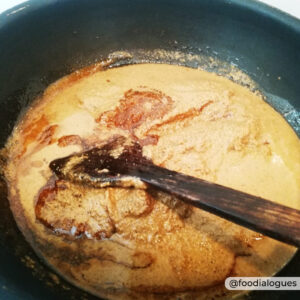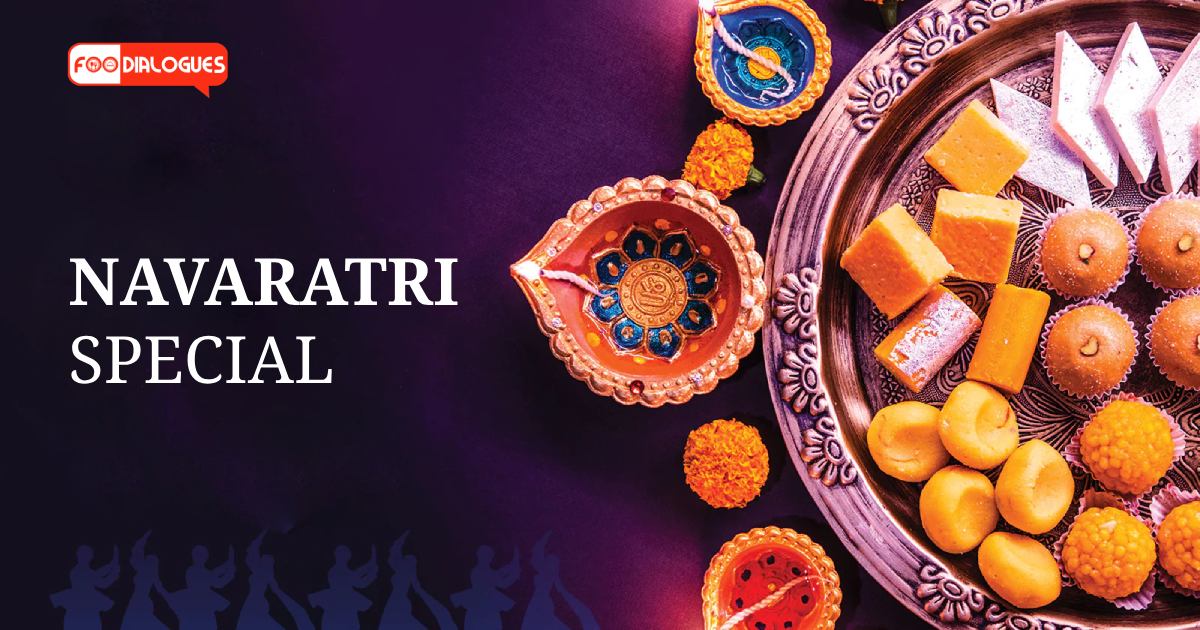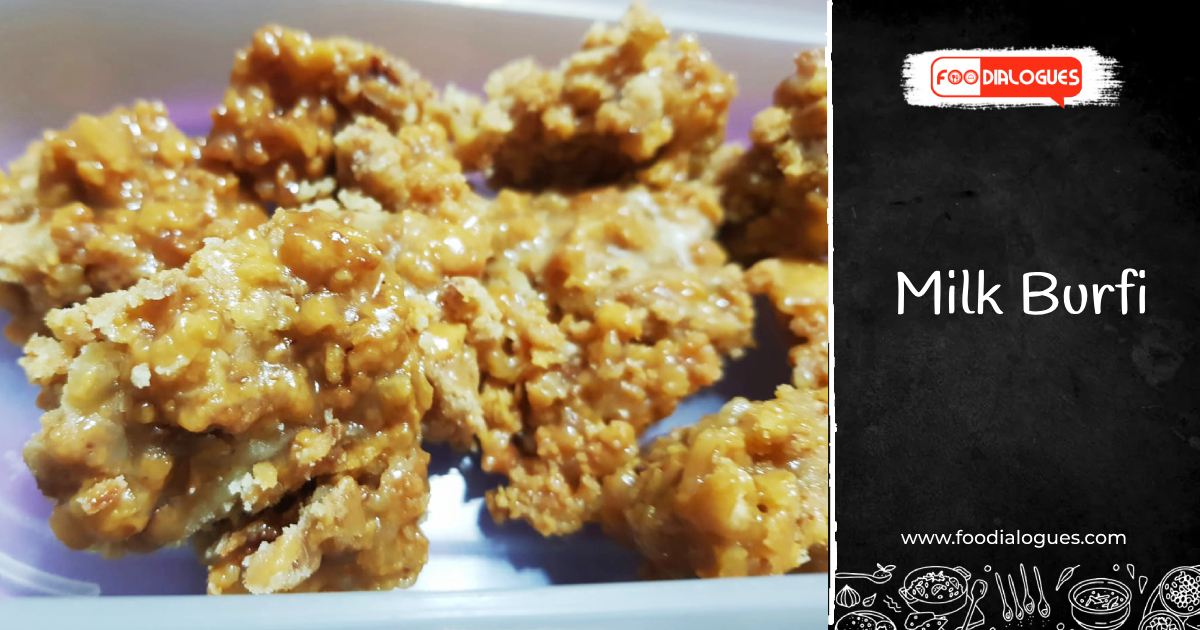The traditions of Deepavali in India has a long history. It is celebrated all over India as a festival symbolizing the triumph of light over darkness.
In North Indian traditions of Deepavali, it is celebrated to honour the victory of Lord Rama over King Ravana and his return home after an exile of 14 years. In South Indian traditions, it marks the victory of Lord Krishna over Narakasura. In the eastern states, especially in West Bengal, it is believed that on this day the furious Goddess Kali defeated the demon Bakasura. Even though the reasons of celebrations are different, most of the traditions of this festival of lights across the country stay the same.
Foodialogues brings to you in its Deepavali series, a whole lot of Sweet and savoury treats keeping in with the traditions of this most celebrated Indian festival.
Deepavali #1
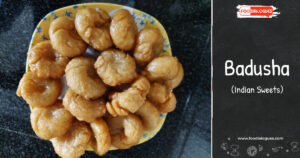
Badusha Sweet Recipe | Badhusha Sweet | Indian Sweet Recipe
A festival steeped in over 2500 years of history, the saga and stories linked to Deepavali/Diwali are vast and varied. While the precise historical emergence of Deepavali is difficult to trace, some of the festival’s most narrated stories, arising from the deep mythology may help shed light on the rich internal diversity nature of the festival. Foodialogues brings to you the leading legends and stories that surround this beautiful festival along with the recipes of delicious Deepavali treats, symbolic of a great celebration.
#1 LEGEND/STORY
DEEPAVALI IN RAMAYANA
Rāmāyana originally composed in Sanskrit, with its primary authorship attributed to Valmiki is one of the most popular epics in the world. It is deeply interwoven into the sociocultural history of India. With 24000 verses, which are divided into six sections (kandams), it belongs to the genre of ancient history or Itihasa . It exerted great influence upon not just art, architecture, and literature, but also served as a repository of traditional practices and customs.
Rāmāyana narrates the exile of Lord Rama an incarnate of lord Vishnu in the human form from the kingdom of Ayodhya for 14 years. Diwali celebrates the triumphant return of Rama to Ayodhya after defeating the demon king Ravana. The Epic symbolises the victory of good over evil, and the power of devotion in human life.
#2 BADAM PURI
Let us join in the fun and gaiety and usher in this divine power into our homes with a delectable easy-to-prepare Badam Puri. The recipe both in English and Tamil and the attached video are available of the easy know-how.

Badam Puri Recipe
#2 LEGEND/STORY
DEEPAVALI & GODDESS LAKSHMI
Deepavali is said to be associated with Lakshmi, the goddess of wealth and prosperity. Goddess Lakshmi is said to have been re-born on Deepavali during the churning of the cosmic ocean (Samudra Manthan). She is believed to visit each house on Deepavali night to bless her worshippers with tremendous wealth and prosperity. The main door is kept open during puja rituals as a sign of welcoming this divine power that transforms all our dreams into reality. People light up the night to guide Lakshmi into their homes and bring good fortune and prosperity for the year to come.
Adi Sankara, in his ninety ninth sloka of Soundarya Lahari indicates the effect of the ‘Upasana’ of Devi as ‘Chandrakala.’ Such an individual will be graced by the Goddesses Lakshmi and Saraswathi! “ Says Sankara, O Mother! One who worships you as Chandrakala shall have the Grace of both Lakshmi and Saraswathi. He shall cut off all connection with ‘Avidya’ or ignorance and shall live forever drinking deep the bliss of heaven!”
Let us on this auspicious day of Deepavali welcome & worship the divine with a tasteful and royal sweet ….the Chandrakala. These fried pastry like half moons are filled with nuts and khoa/mava ,laced with saffron . These sugary twists are an iconic preparation and foodialogues brings to you its recipe, to make your Deepavali immensely joyous.
Deepavali Sweet #3
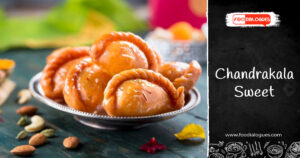
Chandrakala Sweet Recipe
#3 LEGEND/STORY
Deepavali in South of India signifies the victory of lord Krishna over the demon Narakasura. A powerful demon that he was, he took immense pleasure in terrorising people and plundering the kingdoms of the 3 worlds. It was on Krishna Paksha Chaturdashi of the month of Kartika that he was beheaded, and the day is known as Naraka Chaturdashi…….a day of celebration symbolising the victory of good over evil and the death of all negativities. The festival is a harbinger of new light and horizons. It is a day that reminds us of the need to destroy evil thoughts and deeds and strengthen our internal divine forces
#4 LADOO/LADDU
Ladoos/Laddus an endless list of delectable, sweet roundels to celebrate this festival ….As per a popular origin , the history can be traced back to 300-500 BCE. The great Indian physician, Susruta, used Til Ladoos as an antiseptic to treat his surgical patients. The sesame seeds and jaggery with multiple health benefits coated with pure honey, with antibacterial properties was administered. History also narrates that the soldiers of the famed Chola kingdom carried coconut laddus to sustain during wars and as a symbol of good luck.
Over the years, these sweet roundels have evolved into an exciting plethora, experimented, and created with regional ingredients and varying natural sweeteners. Foodialogues brings to 2 innovative recipes of easy sugar-free Ladoos- DATE & ALMOND and NUTTY CARROT /LAUKHI LADOO to enliven your festival and health.
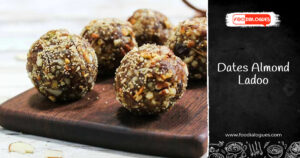
Dates Almond Ladoo | Sugar-Free Sweet | Healthy Sweet Recipes
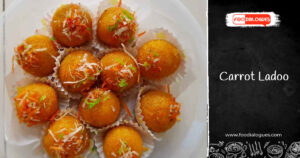
Carrot Ladoo | Sugar-Free Sweet | Healthy Sweet Recipes
#4 LEGEND/STORY
MAHABHARATHA AND DEEPAVALI
Amongst the many other legends associated with Deepavali, is yet another story of exile. The Pancha Pandavas lose all their possessions in a deceitful game of dice against the Kauravas . After 12 years of exile and 1 year incognito life they return to their kingdom on a moonless Karthik Amavasya night. It is believed that the people of the kingdom celebrated that night by lighting thousands of earthen lamps and distributing sweets as a gesture of welcome.
#5 BADAM HALWA
Nuts have always inspired legend and lore, creating a mystique around them . Foodialogues brings to you a rich Indian sweet made of almonds….the badam halwa….A delicious medley of almonds, sugar, ghee, and saffron, an indispensable sweet for Deepavali. An easy sure shot know how of this popular sweet for a perfect badam halwa,that is not cloyingly sweet but with a dominant flavour of the almonds laced with saffron and soft grainy texture.
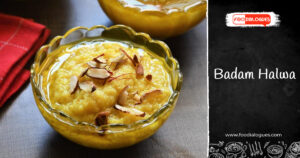
Badam Halwa Recipe
#5 LEGEND/STORY
MAHAVEERA AND DIPALIKA
Jains celebrate Diwali in the name Dipalika or the splendour of lamps. It was on this day that Mahaveera, the twenty-fourth Tirthankara of Jainism attained Nirvana or Moksha in Pawapuri of Nalanda district in Bihar. In the text known as Harivamsha Purana written by Acharya Jinasena, he has mentioned that the Tirthankaras decorated the city with lamps to celebrate the occasion. Swetambar Jains observe fasting for three days around this time. Congregational prayers and readings from Mahaveera’s teachings are very popular on this day. For Jains, this day also marks the birth of a new year.
#6 ASOKA HALWA / PASI PARUPPU HALWA / MOONG DAL HALWA
The small musical town of Thiruvaiyaru in Kumbakonam district has a huge hoarding –“Thiruvaiyaru endraale Ashoka’ simply translated as Thiruvaiyaru is synonymous with Asoka. This is not just a name but an addictive sweet concoction -a famed halwa made with minimalist ingredients with the base being pasi paruppu/moong dal. The similarity to the North Indian moong dal halwa ends here with the common base ingredient. Asoka halwa takes us back to World War II when the shortage of wheat resulted in sweet shops having to shut down production of the famed wheat halwa. Moong dal/ pasi paruppu /green gram dal served as an effective substitute and thus was born this delectable creation.
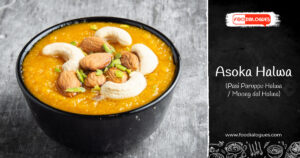
Asoka Halwa Recipe | Moong Dal Halwa | Pasi Paruppu Halwa
#6 LEGEND /STORY
KASHMIR AND DEEPAVALI
Kashmir has a different story linking Lakshmi with Diwali. Kasmira Mahatmyam is an ancient text composed between 500 to 800 AD. It is in this text that for the first time mentions goddess Lakshmi at the centre of Deepavali celebrations. The very name of Deepavali could be traced to this work which has documented the cultural history Kasmiram.
This text mentions about a festival by the name of Deepamala, also known as Sukhasuptika. It was celebrated on the same night of the lunar calendar as Deepavali is celebrated now.
According to Kasmira Mahatmyam, on the new moon night- Amavasya- in the month of Kartik, devotees should worship goddess Lakshmi placing earthen lamps at places visited and resided by them.
#7 GULAB JAMUN
Let us celebrate this festival of joy with homemade Mava / Khoya/ Khova Gulab Jamuns…. A culinary masterpiece that features in most home during this festival of lights.
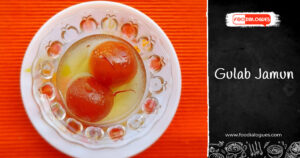
Gulab Jamun Recipe | Homemade
#8 GULAB JAMUN CAKE EGGLESS
‘Life should not be only lived but celebrated” says an inspirational quote . True to this quote Deepavali, a vibrant festival is celebrated with a lot of gaiety & enthusiasm. Traditional sweets are an integral part of this celebration and Foodialogues has taken you all through the sweet journey with snippets, history, and recipes of several traditional sweets. This sweet journey continues but today Foodialogues presents to you a Gulab jamun with a twist —- Gulab Jamun Cake— For all those who want to decrease the sweet and fat quotient without compromising on the flavour and taste.
Thanks to @archkc for this innovation using the Gulab Jamun mix which has substituted a major portion of the regular flour. Hop on to the link for the recipe and get going with the celebration. 🙂
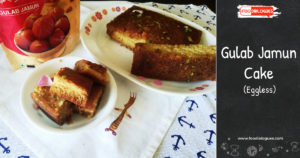
Gulab Jamun Cake (Eggless)
#9 7-CUP CAKE / 7 CUP BURFI
Barfi /Burfi is an original Indian dessert with has a strong resemblance to a fudge. Deriving its name from Persian root “barf” meaning “ice” or “snow’, this sweet concoction is prepared with a base of condensed milk solids (khoa or khoya), granulated sugar, and ghee. The most common ingredients added to the base include nuts, usually pistachios, almonds, cashews, and peanuts. However, fruits, coconut, saffron, rose water or gram flour, are also found in some regional varieties giving the Barfi variations in appearance, texture, and taste.
A common household preparation in Chennai and may be other parts of TN as well, is a special kind of barfi know as the 7-cup cake. I must mention here that the parlance used in Tamizh is “cake” for the barfi….cashew cake. Pista cake, badam cake….The 7-cup denotes the total measures of the ingredients which is again variable . Foodialogues brings to you a 7-Cup recipe which is close to my heart because on the day of my first trial in 2019 my little princess was born.

7 Cup Cake Recipe | 7 Cup Burfi
#10 THENKUZHAL MURUKKU
Deepavali, the festival of lights is around the corner. This festival is all the more special to me because in 2019 my little princess was born close to this festival. This year too the festival and her birthday are just few days apart. Looking forward to the joyous and hectic days ahead brimming with the spirit of celebrations with my little ones. Foodialogues brings to you a simple savoury which is a must on the to-do list during Deepavali….. The crunchy coils of thenkuzhal… A type of crispy murukku that’s addictive.
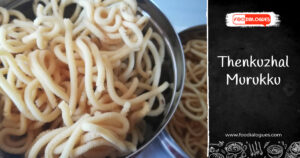
Thenkuzhal Murukku Recipe
#11 ELANEER PAYASAM
A day so special, when a dazzling ray of sunshine entered our home. Little “D, My Princess …Cute & Pretty, Charming & Bubbly, Curious & Adventurous…a bundle of mischief…. She has made my world even more interesting and given me an opportunity to pursue my favourite pastime ..SHOPPING…with zeal and enthusiasm. From cooing to babbling to a clear “thank you paati” which still rings in my ears, it’s unbelievable that she is just turning 3. Celebrating this sunshine in my life and the sparkles of Deepavali, Foodialogues brings to you a special payasam… Elaneer payasam. Made with tender coconut water, coconut cream, and whole-fat milk this is a refreshing dessert fit for celebration.
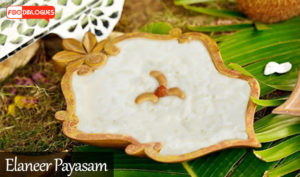
Elaneer Payasam
#12 DEEPAVALI LEGIYAM
Deepavali legiyam also known as marundu is a preparation using native herbs and spices. As the name connotes, this preparation is a kind of indigenous medicine which is not only digestive in nature but also wards off all ailments such as fever, cold and cough which is imperative during the monsoons in the South. The weather also changes from hot and humid to cold and chilly and our ancestors had the ingenuity to incorporate this native medicine as a must-have on Deepavali day after the ceremonial oil bath.In fact it is the first food if you can call it so that enters into our digestive system on that day.
The recipe given to me by my mother is shared here with you. The English version will be updated after the festival. Also note that sesame oil and ghee is used in equal quantities and jaggery adds to the taste and levels the spice quotient.

#13 DRY FRUIT LADOO
Deepavali is around the corner. Along with the mood for celebrations is the growing concern over the high consumption of added sugars. The celebratory treats are drooling concoctions of sugar, oil, ghee and milk solids which are not just a feast to the eye and taste buds but also to the invisible monsters …the lifestyle disorders where diabetes rules the roost. Moderation and portion control is the key but do we have other options???? Foodialogues shares with you a simple easy-to-prepare date and nut ladoo / burfi with no added sugar or artificial sweetener.
Dates with 60% natural glucose & fructose and an average GI of 42 is an excellent substitute for added sugar and safe for diabetics when consumed in moderation. A good source of fibre and antioxidants it helps in slow absorption of sugar into the bloodstream and prevents sugar spikes. Concentrated source of magnesium and potassium, the two important minerals in blood sugar control. Dates during Deepavali not only elevates your celebratory mood but also enhances your health and safety.
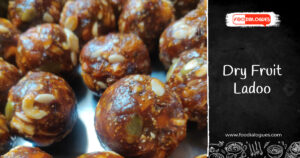
Dry Fruit Ladoo Recipe | Sugar-Free Dates Laddo
#14 Thenkuzhal
Thenkuzhal….spangled spirals of tradition….crisp and crunchy loaded with flavors of cumin and sesame is a Deepavali staple in my house. The ratio between Urad dal and raw rice can create different versions of thenkuzhal. Greater proportion of dal gives you a seamless twist while more rice results in crisper and shorter version with less spangled mass. Foodialogues shares with you both the proportions for a joyful Deepavali.

Thenkuzhal Murukku Recipe | Version 1.0 & 2.0
#15 Fruit Jelebi
Apples…… Delicious, nutritious, and convenient to eat. It’s a fruit packed with vitamins and fibre, which helps balance blood sugar levels and promote satiety. Foodialogues shares a fruity jelebi with apple as the core. The yeast-fermented coating lends that exact jelebi flavour and crisp texture. Eat the fried jelebi as it is without the customary dip in sugar syrup, dust it with sugar powder, or dip in ½ string sugar syrup. Apples mitigate sugar spikes when they are combined with fat. Use any oil of your choice and slice apples along with the peel. An unusual sweet to light up your Deepavali without a guilt.

Fruit Jelebi Recipe with Video | Recipe in Tamil
#16 Gulab Jamun Cake
Gulab Jamun, the Indian celebratory dessert is a household essential on Deepavali. The sweet with Persian origin and long-standing history begins with a laborious preparation of condensing milk into khoa. The deep-fried khoa balls floating in a saffron-laced sugar syrup is a delight despite the labor that goes into its making. The sweet preparation evolved with milk powder and condensed milk as the base thus freeing the home makers and halwais from the strain of preparation. Thanks to convenience food manufacturers, the instant version hit the market as early as 1960. The instant Gulab Jamun Mixes made the preparation absolutely effortless, and this sweet made its way into all homes. Today Foodialogues shares with you an unusual perspective of this traditional sweet…… A Gulab Jamun Cake….. No compromise on the taste or flavor…click on the link and give it a try…. Happy Deepavali.

Gulab Jamun Cake (Eggless)
#17 Aval-Pori Masala Vadai
Deepavali and food indulgence go hand in hand. The day starts with food and ends with food…abundant, rich & delicious. The endless array of sweets and snacks vary from household to household. Yesteryears in my home the day traditionally began with hot steaming idlies, crisp bajjis, and ghee oozing nut-loaded wheat halwa….all painstakingly made at home The elaborate lunch menu would have more such deep fry delicacies of which Vada would be the king. Mysorepak, Cashew burfi, Boondi laddu, Badusha, Gulab Jamun, thenkuzhal, paal payasam would be the in-between snack. The day would end with hot idlies again. With moving times practices have changed. It’s an all-encompassing brunch with a light festive dinner but Vada still reigns supreme along with payasam. Innovative recipes have crept in and a balance struck between tradition and creativity. Foodialogues shares the recipe of a quick vada….. Aval-Pori Masala Vadai… made with puffed and beaten rice…. Crisp and flavorful and does away with the labor of soaking and grinding.



